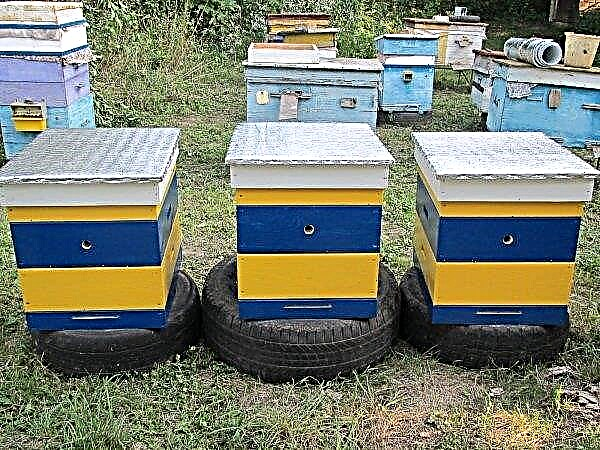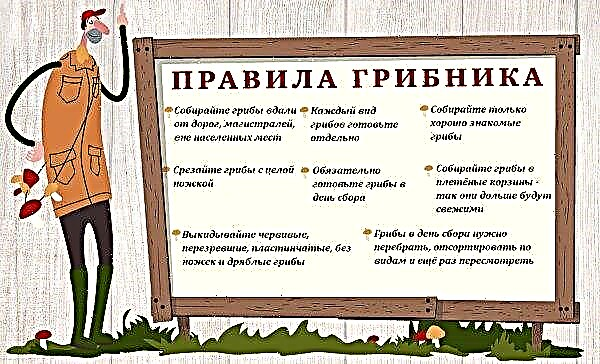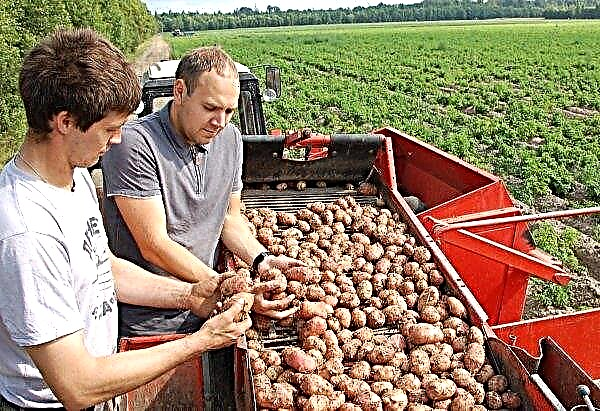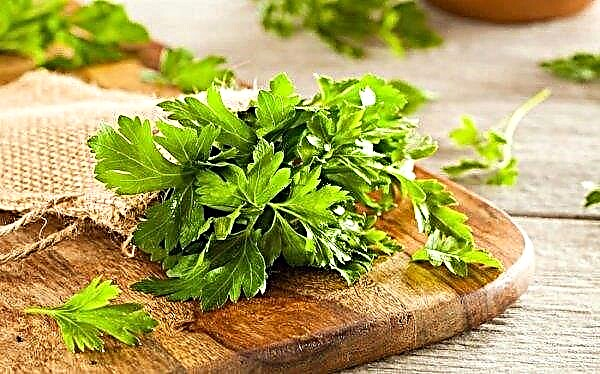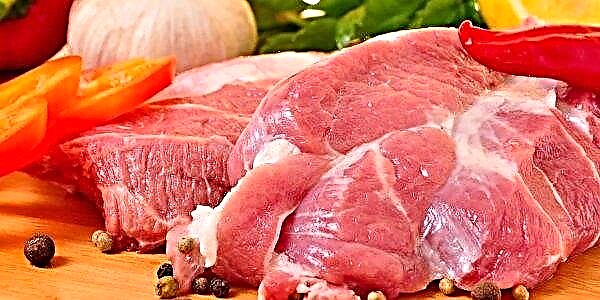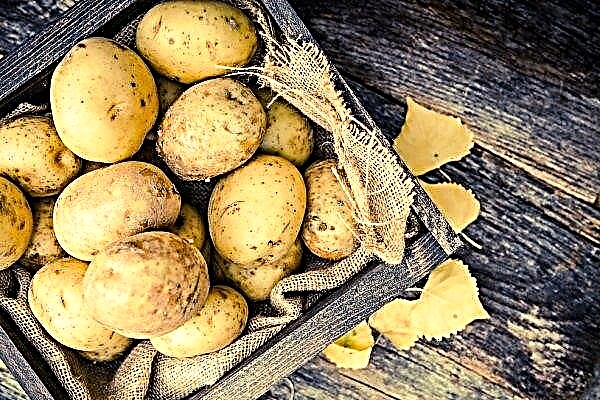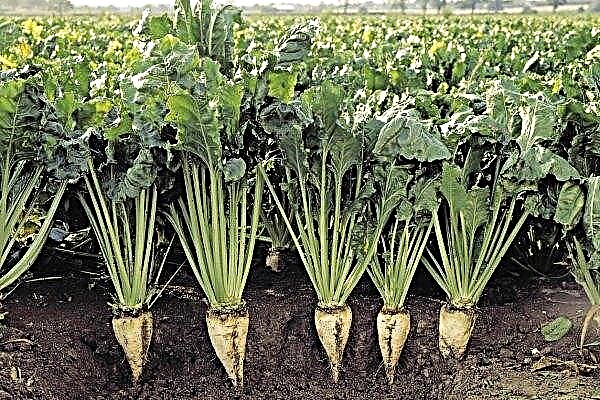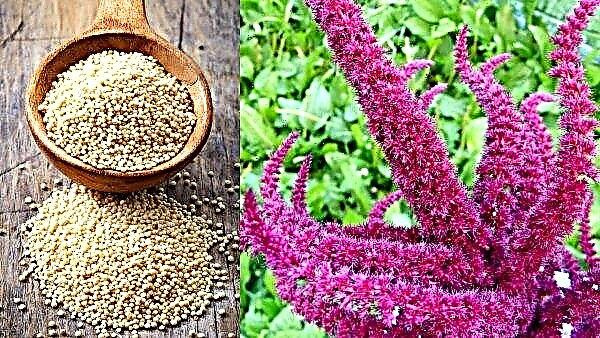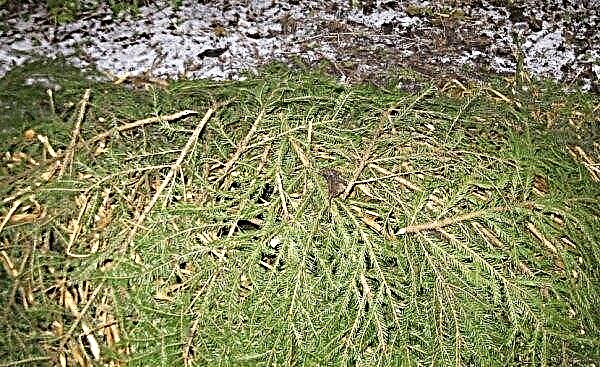Among a wide variety of plum varieties, Bogatyrskaya is recognized and loved by many consumers for its excellent taste and large fruit size. The variety is also in demand among gardeners due to its productivity, frost resistance and attractive presentation.
Description and distinguishing features of the plum variety Bogatyrskaya
The appearance of this variety in the late 80s of the XX century occurred during breeding work on the crossing of two popular varieties - Ispolinskaya and Vengerka. As a result, the Bogatyrskaya cultivar is characterized by late or very late ripening; harvested ripeness occurs in the second decade of August. Plum trees are classified as tall until the time of bearing fruiting, after which their intensive growth slows down a little, and they acquire the status of mid-growth. Crohn has a medium density, spreading. The bark is colored gray in the area of the stem and central branches, has a light rough structure. Branches of a pale color, indirect, grow at an acute angle to the trunk. Shoots with a large number of lentils are painted in gray. The buds are small, conical in shape, brown in color, and also grow at an acute angle. Plum leaves have a dark green color on the upper part and a lighter tone on the lower. They are obovate in shape with a sharp base. Flowering tree occurs in early May. White flowers are medium in size, 2-3 pieces in inflorescences are combined. Fruiting occurs according to a mixed type: fruits are formed mainly on bouquet branches, last year's long growths and spurs.
Shoots with a large number of lentils are painted in gray. The buds are small, conical in shape, brown in color, and also grow at an acute angle. Plum leaves have a dark green color on the upper part and a lighter tone on the lower. They are obovate in shape with a sharp base. Flowering tree occurs in early May. White flowers are medium in size, 2-3 pieces in inflorescences are combined. Fruiting occurs according to a mixed type: fruits are formed mainly on bouquet branches, last year's long growths and spurs.
Important! Bogatyrskaya plum needs crop rationing, which will allow it to regulate the load on the tree and collect large-sized fruits.
Bogatyrskaya belongs to self-fertile varieties, that is, it does not need pollinating neighbors. Large plum fruits, on average 40 g, can reach 50-60 g. They are dark purple in color, almost black when ripe, elongated-oval. The seam on the sink is clearly visible. Thick, waxy peel. The plum pulp has a green-yellow color, juicy and tender. The stone is of standard size and shape, occupies 8% of the fruit mass, is well separated from the pulp. With an excess of moisture, the skin does not crack. Juice of a transparent color. The taste of fruits is sweet and sour with a honey tint. The amount of sugar does not exceed 13%, and ascorbic acid in plums is almost 9.63 mg per 100 g of product. Bogatyrskaya can be used both fresh and for processing.
The stone is of standard size and shape, occupies 8% of the fruit mass, is well separated from the pulp. With an excess of moisture, the skin does not crack. Juice of a transparent color. The taste of fruits is sweet and sour with a honey tint. The amount of sugar does not exceed 13%, and ascorbic acid in plums is almost 9.63 mg per 100 g of product. Bogatyrskaya can be used both fresh and for processing.
Advantages and disadvantages
- In the course of breeding, scientists tried to create a variety with the maximum number of positive characteristics, which include the Bogatyr plum:
- high productivity, can be used for intensive gardening. The variety is suitable for a mechanized method of harvesting;
- annual fruiting;
- good resistance to low temperatures and frost;
- high immunity against many diseases and pests dangerous to fruit trees;
- self-fertility of the variety, there is no need to plant additional trees for pollination in the garden;
- the bone is well separated from the pulp of the fetus;
- good and pleasant taste;
- resistance of fruits to cracking during heavy rainfall;
- excellent transportability of fruits, thanks to a dense skin;
- universality of application.
However, one of the main positive properties - high productivity, is also the main drawback of the Bogatyr plum, as the tree may suffer from fruit overload. Sufficiently strong branches can break under too heavy a mass of drains. Also, a large load on the tree can lead to the fact that subsequent crops will be smaller.
Did you know? Plum blossoms contain a large amount of nectar, so in apiaries located near plum gardens, you can get up to 10 kg of honey from 1 ha of plantings.
Productivity and fruiting
The variety is not characterized by high early maturity; it begins to produce crops 4–5 years after planting a seedling at the age of one. The heroic one is self-pollinated, and its flowering occurs at the end of May. The variety is late ripening, and the fruits are ripened in the middle or end of August. The tree bears fruit stably every year, and already 5–6-year-old plants can bring up to 50–70 kg of crop per season, and then their productivity can increase to 60–80 kg in adult trees. Plum can bear fruit 15-30 years, depending on the stock and quality of care.
The tree bears fruit stably every year, and already 5–6-year-old plants can bring up to 50–70 kg of crop per season, and then their productivity can increase to 60–80 kg in adult trees. Plum can bear fruit 15-30 years, depending on the stock and quality of care.
Disease and pest resistance
The breeding advantage of the variety is Bogatyrskaya's resistance to a large number of the most common fungal diseases and infections. By creating quality care, regular inspection and timely prevention for the plant, you can provide reliable protection from other ailments and pests.
Features of planting a hero tree
The process of preparation for planting begins long before the immediate planting of a seedling and includes the following steps:
- selection and preparation of the optimal garden plot;
- procurement of high-quality planting material;
- its preplant treatment;
- planting a seedling.

Recommended Dates
They begin to prepare the planting pit in the fall, if the seedlings are planted in the spring, and vice versa, if the autumn planting is planned. Most gardeners are inclined to consider that planting seedlings in April before budding is the most optimal. In the case of acquisition of plum seedlings in the fall, they can be preserved until the arrival of spring by placing them in the trenches and covering them with spruce branches. However, it is permissible to plant a plum in the autumn period, then agricultural procedures are carried out until mid-October.
Did you know? If you plant Bogatyrskaya and another plum variety in one of the garden plots in the immediate vicinity, the total yield will almost double.
Choosing the right place
At the planning stage of planting a plum garden, you should pay attention to the areas:
- with the occurrence of groundwater at a depth of 1.5 m or more. Closer location of moisture can lead to stagnation in the soil, hinder aeration, air access to the roots of the plant;
- slopes, flat areas, as well as small hills that are well lit by the sun;
- hidden from the wind or located close to fences, which can partially act as protection against drafts and strong air mass flows.
 Plum is very sensitive to the soil in which it grows; therefore, for its successful growth and fruiting, the soil must have neutral acidity, pH 6–7. If this indicator at the site selected for planting is slightly overestimated, then it can be lowered using ash or dolomite flour at the rate of 800 g / m², which are added to the soil 1-2 days before planting. You can also correct the situation with a shallow groundwater, for which they build a hill with a diameter of 1 m and a height of 40–70 cm.
Plum is very sensitive to the soil in which it grows; therefore, for its successful growth and fruiting, the soil must have neutral acidity, pH 6–7. If this indicator at the site selected for planting is slightly overestimated, then it can be lowered using ash or dolomite flour at the rate of 800 g / m², which are added to the soil 1-2 days before planting. You can also correct the situation with a shallow groundwater, for which they build a hill with a diameter of 1 m and a height of 40–70 cm.Important! If a tree is planted in the shade, it will bring a small crop, and its leaves will change their color, brighten from lack of sunlight.
Selection and preparation of planting material
Seedlings suitable for planting should be:
- annual or biennial;
- seedling growth - 1–1.4 m and a standard size of 40–60 cm;
- have a developed rhizome, the size of which should reach 25-30 cm;
- have 3 or more main processes 15-30 cm long;
- the bark should be flexible, without rot and dry shoots.
It is recommended to purchase planting material from trusted suppliers who care about the quality of the seedlings and comply with the rules for their procurement and processing. After the acquisition of seedlings, their rhizome is wrapped in a wet cloth to prevent them from drying out, and if the purchase of planting material was made long before planting, it is recommended to tuck the rhizome. Soaking the roots of seedlings in an earthenware clatter On the eve of planting, the seedlings must be processed. For this, its a third immersed in a weak solution of potassium permanganate, after which the roots are treated with a mixture of clay and manure, taken in a ratio of 2: 1. After greasing the roots, they are left to dry for several hours, then the seedling is ready for planting.
Soaking the roots of seedlings in an earthenware clatter On the eve of planting, the seedlings must be processed. For this, its a third immersed in a weak solution of potassium permanganate, after which the roots are treated with a mixture of clay and manure, taken in a ratio of 2: 1. After greasing the roots, they are left to dry for several hours, then the seedling is ready for planting.
Direct landing
Preparation of the landing pit begins in advance:
- First, mark the diameter, the value of which should be 80-100 cm.
- Next, remove the top layer of soil with a thickness of 20 cm.
- Dig a hole with a depth of 50-60 cm.
- Mix the dug up earth with superphosphate, potassium salt, humus and compost. If the soil is clay, river sand is introduced into it, and if sandy, powder clay is applied.
- An earthen pillow with fertilizers in the form of a hill is laid out in the landing pit.
- Cover the pit with a waterproof film.
 1 - a mixture of earth with pus; 2 - ground from the top layer; 3 - small pegs; 4 - irrigation hole; 5 - landing stake; 6 - shtambik tree; 7 - hole roller; 8 - landing board
1 - a mixture of earth with pus; 2 - ground from the top layer; 3 - small pegs; 4 - irrigation hole; 5 - landing stake; 6 - shtambik tree; 7 - hole roller; 8 - landing boardLanding occurs according to the following technology:
- Preparation of the landing pit, which is described in detail above.
- Installation of a support peg about 150-170 cm high, which will support a growing tree in the early years. It is dug at a distance of 15–20 cm from the center of the pit.
- On the prepared earthen hill inside the pit, a seedling is set, carefully spreading the roots. After that, the rhizome of the tree is sprinkled with soil in such a way that the root neck is 3-5 cm above ground level.
- It is necessary to compact the earth and, having retreated about 30 cm from the trunk, dig a shallow, about 10 cm hole in a circle. 40-50 l of water is poured into this recess for irrigation immediately after planting.
- The trunk circle is covered with nutrients and mulched, organic peat and humus can be used.
- The tree is fixed to the peg with soft twine.
Video: planting plum seedlings
Plant care
Bogatyrskaya plum trees need the same care as most other fruit trees:
- they need annual pruning of branches or formation - removal of those processes that depart from the trunk at an acute angle and can break under the weight of the crop;
- timely watering and control of soil moisture, especially during flowering and fruiting;
- weed removal;
- loosening the soil;
- pruning dry branches and collecting fallen leaves before wintering;
- soil mulching;
- crop rationing.
Important! Seasonal pruning of trees helps to normalize crops, promotes their active fruiting, and also serves as a preventive measure to protect diseases, injuries and pests.
Particular attention should be paid to the rationing of the crop, since the Bogatyrskaya variety brings a very abundant plum crop, and there is a risk of branch breakage under the heavy weight of the fruit. To do this, it is recommended to remove half of the ovaries that appear on the tree. This procedure is performed in two stages:
- ¼ part is removed when the ovaries grow to the size of a hazelnut.
- ¼ part break off when the ovary grows twice.
Watering and loosening the soil
Trees of this variety are very fond of wet soil. Watering should be plentiful, but not very frequent, in order to prevent rotting of the roots and the appearance of fungal diseases. If you water the tree too actively, then the leaves will begin to turn yellow. Watering should be in an annular groove dug after planting a tree. After watering, the soil under the tree is fertilized with humus and mulched to maintain moisture. The flow of life-giving moisture is especially important during the period of flowering and ripening of plums. The irrigation volume is 20–30 liters per week for a young tree and 50–60 liters for an actively fruiting plum. After irrigation and rainfall, the soil is loosened to improve aeration. It is also necessary to remove weeds that can take away nutrients from the tree.
The flow of life-giving moisture is especially important during the period of flowering and ripening of plums. The irrigation volume is 20–30 liters per week for a young tree and 50–60 liters for an actively fruiting plum. After irrigation and rainfall, the soil is loosened to improve aeration. It is also necessary to remove weeds that can take away nutrients from the tree.
Tree feeding
Since a sufficiently large amount of nutrients is introduced into the pit during planting, there is no need to fertilize the soil in the first year of growth. From 2-3 years, you can start fertilizing with mineral substances:
- phosphorus, potassium are added in the autumn;
- spring after flowering - nitrogen fertilizers.
Thus, the tree is nourished according to the following scheme:
- At the beginning and end of June, fertilizer “Ideal” or urea solution is added.
- In early May, they also feed the root system with a urea solution, followed by watering.
- The beginning of June - a solution of nitrophosphate.
- August - an aqueous solution of superphosphate and potassium sulfate.

For adult trees that bring a stable crop, fertilizer is applied according to the following system:
- Before flowering begins: a solution of urea and potassium sulfate.
- During fruit ripening: prepare a solution for irrigation from urea and nitrophoska, and also pour a bucket of compost or humus into the trunk circle and 1 cup of chalk.
- At the end of fruiting: during irrigation, a solution of potassium sulfate and superphosphate.
Cropping technology
Trimming branches can be done with the aim of:
- the formation of an attractive and unfrozen crown;
- sanitary disposal of dried and damaged processes and branches.
The formation of the crown of plums occurs in the spring and falls at the end of March - beginning of April. The key point is the temperature regime, since the air should be sufficiently warmed up, not lower than + 10 ° C. Pruning involves the removal of branches that are at a very sharp angle to the trunk and are at risk of breaking off during the fruiting period of the tree. If this happens, then the tree is injured, and it needs strength to recover, which can affect yield.
Important! No more than ать of the total number of branches can be pruned so that the plant does not receive a strong shock.
In addition, an injured tree is susceptible to pests and may begin to hurt. The best option for trimming is an improved longline form, which is created gradually, as the tree grows. It is possible to conduct summer trim pruning when the crown is made less thickened. Annual growths of 30–40 cm in length are not removed, cutting the lateral 50–60 cm branches by a quarter, and thickening, directed inward branches are removed. Spring sanitary pruning is carried out in April-May, in the process processes damaged by frost, dry and broken branches under the weight of snow are removed. Slices must be treated with garden var. It is also appropriate to carry out sanitary autumn pruning at the end of the fruiting of the tree, which is recommended for October - early November.
Spring sanitary pruning is carried out in April-May, in the process processes damaged by frost, dry and broken branches under the weight of snow are removed. Slices must be treated with garden var. It is also appropriate to carry out sanitary autumn pruning at the end of the fruiting of the tree, which is recommended for October - early November.
This time, sick, dry, injured branches and processes are removed. However, you should be careful, because fresh cuts may not heal before the onset of frost, which will significantly weaken the tree, and it may suffer or even freeze.
Video: prune pruning
Winter preparations
The characteristics of the variety indicate that it is frost-resistant, but proper care of the tree and the creation of favorable conditions for wintering will help the sink easier to tolerate cold weather and temperature fluctuations.
Did you know? Plumkot is a hybrid obtained by crossing plums and apricots, which is gaining popularity in many European countries.
So, preparation for the winter cold occurs as follows:
- In mid-October, the area around the trunk is cleared of fallen leaves.
- Then it is necessary to water the earth, loosen it and mulch it well to preserve moisture in it for a longer period. Watering should be in such a volume that the soil becomes moist to a depth of at least 1 m. Peat or sawdust can be used as mulch, the layer of which should be 5–7 cm.
- The surface of the trunk and the main branches are inspected and the dead parts of the bark, moss and lichens are removed.Damaged areas are treated with iron sulfate or garden var.
- The tree stem and its branches are treated with a lime mortar, which is prepared from lime and clay.
- In order to prevent freezing of the rhizome, it is recommended to create a small earthen pillow up to 20 cm, for which purpose, under the trunk and near-trunk area, the earth is raked from the site.
- Also to save heat, you can use spruce spruce branches, which will also provide protection from mice and hares.
Video: preparing plums for winter
Possible diseases and pests
The Bogatyrskaya sorted variety plum has a fairly good immunity against the most common diseases and is practically not affected by pests, however, you should be aware of the ways to prevent and combat some of them:
- Holey spotting - fungus, resulting in brown spots on the leaves, the formation of holes on them. It is distributed in wet conditions. Prevention - the collection and burning of fallen leaves.

- Soot fungus - black coating on the foliage. Prevention - crown formation, thinning and timely watering.

- Rust - a coating similar to rust spots. Affected leaves are removed, preventing spread.

- Fruit rot - gray spots on fruits, which lead to their gradual drying, for which fruits with such signs immediately need to be removed.

- Marsupial disease - A disease in which the branches of a tree become hollow inside. Branches with such signs must be immediately removed and burned.

Pests that can affect the growth and fruiting of plums:
- hawthorn;
- goldfish;
- plum aphid;
- fruit mites;
- yellow plum sawfly;
- codling moth.
We recommend that you familiarize yourself with the latest varieties of plums such as:
Harvesting and storage
Bogatyrskaya plums ripen by mid-August. Having collected a plentiful harvest, the fruits are stacked in boxes in several layers, since the fruits have a dense skin and are not injured. In the process, it is necessary to discard damaged and overripe plums. Further, the boxes can be placed in a cool room, which can be used as a basement or refrigerator. The variety is successfully transported without loss of commercial quality. The optimal conditions for storage for several weeks are:
The optimal conditions for storage for several weeks are:
- temperature + 5 ° C;
- humidity 80–90%.
If longer storage is required, then the fruit must be processed with special means. Bogatyrskaya is a universal variety with high yield, good commercial qualities and the possibility of consumption both in fresh and in processed form.






